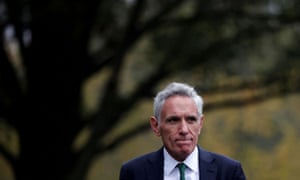White House coronavirus adviser Atlas apologizes for Russian TV interview
WASHINGTON (Reuters) - White House coronavirus adviser Scott Atlas apologized on Sunday for giving an interview to Russia’s Kremlin-backed television station RT, saying he was unaware the outlet was a registered foreign agent in the United States.

Atlas, a neuroradiologist and member of the White House coronavirus task force, appeared on the channel on Saturday and criticized coronavirus lockdowns measures, calling them an “epic failure” at stopping the virus’ spread.
“I recently did an interview with RT and was unaware they are a registered foreign agent,” Atlas wrote on Twitter. “I regret doing the interview and apologize for allowing myself to be taken advantage of.
“I especially apologize to the national security community who is working hard to defend us,” Atlas said.
RT registered as a foreign agent three years ago. A January 2017 report from U.S. intelligence agencies said the television station, which broadcasts on cable in the United States, is “Russia’s state-run propaganda machine” and that it contributed to the Kremlin’s campaign to interfere with the 2016 presidential election in favor of the winning candidate, Republican President Donald Trump.
After that report, the U.S. Department of Justice insisted that RT America comply with requirements under the Foreign Agent Registration Act (FARA).
“The lockdowns ... will go down as an epic failure of public policy by people who refused to accept they were wrong,” Atlas told RT in the Saturday interview.

Public health experts in the United States have previously raised concerns that Atlas, who has no background in infectious diseases, is providing misleading or incorrect information on the pandemic to Trump.
Anthony Fauci, the leading U.S. infectious disease expert, said on Saturday that Atlas is the only pandemic adviser who Trump regularly sees.
“I have real problems with that guy,” Fauci told the Washington Post. “He’s a smart guy who’s talking about things that I believe he doesn’t have any real insight or knowledge or experience in.”
Scott Atlas tweeted: ‘Masks work? NO!’
Ed Pilkington in New York
Mon 19 Oct 2020

Twitter has removed a tweet by Scott Atlas, a controversial scientist who has Donald Trump’s ear, in which he wrongly stated that masks fail to protect against coronavirus.

The Washington Post, meanwhile, reported that Atlas has scattered discord inside the White House, so infuriating Deborah Birx, the coronavirus response coordinator, that she complained to Vice-President Mike Pence, calling for Atlas to be removed.
The Post reported that at one meeting in the Oval Office, Atlas placed himself behind the Resolute Desk after Trump had left the room. The scientist, a senior fellow from Stanford’s conservative Hoover Institution, denied the account.
On Sunday, Twitter took down the tweet in which Atlas said: “Masks work? NO.” The company said the post violated its policy on Covid-19 misinformation that prohibits “sharing false or misleading content which could lead to harm”.

In a stream of posts, Atlas falsely claimed that several US states and other countries had taken up widespread use of masks without evidence of any positive effect. He also incorrectly said that there were “many harms” to the practice.
Twitter’s move to block Atlas’s public comments is the latest controversy to hit since he joined the White House as a pandemic adviser in August.
A neuroradiologist, Atlas has no training in virology or epidemiology yet is understood to have become the key scientific influence on the president, eclipsing respected experts such as Anthony Fauci, the country’s top specialist in infectious diseases.
Atlas’s views on how to deal with the virus have raised alarm in scientific circles. He has repeatedly cast doubt on masks and social distancing, and suggested people could gain natural self-defenses against the disease even without a vaccine through “herd immunity”.
Shortly after his appointment to the White House, 78 of his former colleagues at Stanford medical school wrote an open letter in which they lamented that many of Atlas’s opinions “run counter to established science”. Robert Redfield, head of the Centers for Disease Control and Prevention (CDC), was recently overheard discussing Atlas on a phone call. “Everything he says is false,” Redfield said.
Coronavirus is back on the ascendant, across the US. Data compiled by Johns Hopkins records more than 8m confirmed cases, with almost 220,000 deaths.
Friday saw the daily number of confirmed cases exceed 70,000 for the first time since July, with almost 900 deaths. In a leaked report, the White House put 26 states in the “red zone” – indicating a dangerous level of new infections – including almost all states in the midwest.
The surge in cases spells political peril for Trump as he finalizes his push for re-election in two weeks’ time. His rival, former vice-president Joe Biden, has put criticism of Trump’s handling of the pandemic at the center of his campaign.
Despite the rising numbers, and despite his own recent illness from the disease, Trump has stuck to his line that the threat of the virus is overplayed. At a rally in Nevada on Sunday he repeated his false claim that the US was “rounding the turn”.
In North Carolina on Sunday, Biden said: “As my grandfather would say, ‘This guy’s gone around the bend if he thinks we’ve turned the corner.’ Things are getting worse, and he continues to lie to us about circumstances.”
Trump and Atlas have regularly been seen in public without wearing masks. Their behavior goes against the official advice of the administration’s own public health agency, the CDC, which recommends mask-wearing in public settings.
Masks are particularly important for preventing the spread of the virus from people who show no symptoms and may not know they are contagious. Face coverings are primarily useful in protecting other people, rather than the individuals wearing them.



















